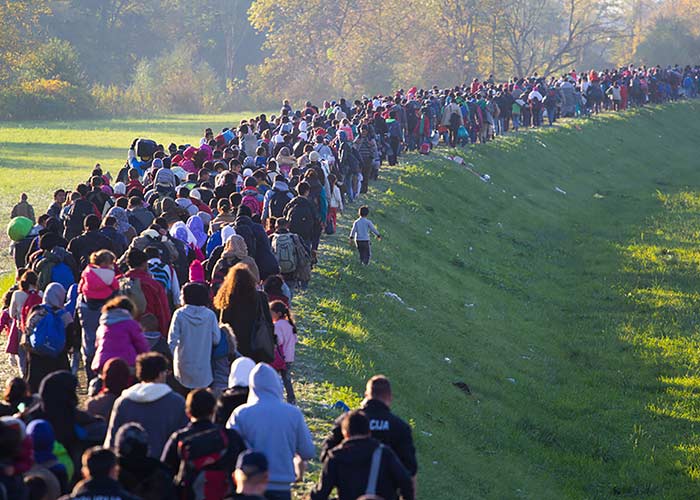“World Wildlife Day” celebrates all the species of animals and plants in our eco system and their significance. They day admires their contribution to the bio diversity of the planet and acknowledges the fact that the extinction of wildlife will lead to the collapse of eco system.
Celebrated globally every year on 3rd March; World Wild Life Day was first observed in 2014 and has since become the world’s most significant wildlife event.
The UNGA Resolution
The proclamation to celebrate 3rd March annually as “World Wildlife Day” was made by the UNGA (United Nations General Assembly) in its 68th session on 20th December 2013.
The date of observation of World Wildlife Day – 3rd March, coincides with the adoption of the CITES (Convention on International Trade in Endangered Species); which is a multilateral treaty with 183 parties to protect endangered species and plants.
The “World Wildlife Day” was first proposed by Thailand, in CITES’s 16th conference of parties held at Bangkok in 2013 and subsequently the United Nations General Assembly adopted a resolution on 20th December 2013 to celebrate 3rd March as the “World Wildlife Day”.
The United Nations General Assembly designated CITES Secretariat as the facilitator of the celebrations of “World Wildlife Day”.
World Wildlife Day 2025
World Wildlife Day 2025 will be celebrated on 3rd March, Monday.
The event was celebrated with the aim of saving wildlife in water bodies and how they help in maintaining the biodiversity and environment equilibrium on earth. There were series of events organized in the world including art competitions, short film festivals, and awareness campaigns on social media.
The United Nations, in collaboration with the UNDP (United Nations Development Programme) organized an art contest to mark the World Wildlife Day 2019. The winner of the contest was a seventeen year old girl named Valerie Dou.
On World Wildlife Day 2019, India is all set to become the first country in the world to get the King Cobra sanctuary. The sanctuary will be setup in Agumbe, a village in Karnataka which is considered as the home of King Cobras. It will be because of the great efforts of Romulus Whitaker, the renowned wildlife conservationist and herpetologist who advocated building a sanctuary in the village to make a safe home for the species.
What is the Theme of World Wildlife Day 2025?
World wildlife day theme 2025 will focus on “Wildlife Conservation Finance: Investing in People and Planet”. This year the celebrations will focus on people and planet.
Why is “world wildlife day” celebrated?
The world is abounding with flora and fauna. All the species of plants, animals and birds contribute to the existence of eco system in their own unique way. Wildlife has coexisted with human habitation since ages and one has become an integral part of another’s life.
Wildlife benefits us in innumerable ways: providing food, medicines apart from maintaining climate and regulating rains and replenishing natural resources. Not to mention the oxygen that lush green forest provide at the same time acting as natural air filters by cleaning the air.
Recognizing the contribution of flora and fauna into the environment and acknowledging its essentiality for existence of life on earth, the United Nations constituted CITES (Convention on International Trade in Endangered Species of Wild Fauna and Flora) on 3rd March 1973 to protect and preserve the planet’s wildlife.
What is the need for “world wildlife day”?
Wildlife plays a very important role in the eco system and is essential for the existence of any form of life. Humans have existed together with wildlife for ages and have acknowledged the importance of wildlife.
Unfortunately we are losing our wildlife to factors like habitat extension, illegal trade or poaching, industrialization and population etc. The number of species of animals and plants are depleting at a fast pace and at an unprecedented rate never witnessed before.
Approximately 200 species of plants and animals are estimated to be getting extinct every 24 hours, which accounts to nearly 73000 species of plants and animals annually.
Considering the contribution of wildlife in balancing the eco system by causing rainfall, regulating climate, providing oxygen, providing medicine, herbs and food, increasing fertility of soil and regulating floods among various others.
We cannot afford losing the wildlife as it is imperative for the survival of humans. The earth with no wildlife will be a desolate and dry planet, impossible for survival of humans. Therefore, it becomes essential to protect and preserve the wildlife for our own good and for the longevity of the planet.
Celebrating our rich wildlife heritage on the “World Wildlife Day” is a good initiative in the way of protecting our flora and fauna. On “World Wildlife Day”, the threats to the wildlife are assessed and possible means of their elimination are devised. The celebrations are very important to raise awareness about the significance of wildlife.
What constitutes the greatest threat to wildlife?
- Habitat Loss
Habitat loss constitutes the greatest threat to the wildlife. According to a global estimate, approximately 50000 species are getting extinct annually due to deforestation and loss of habitat.
When humans expand their boundaries, they encroach into the wildlife, ultimately resulting in the loss of species’ natural habitat and their extinction. The extension of human settlement into the forest also results in man animal conflict, in which the animals ultimately pay the price.
- Illegal Trade and Wildlife
Illegal trade cartels dealing in restricted wildlife products and poaching constitute one of the greatest threats to the wildlife. Every year when many species are pushed near to extinction, illegal traders make millions by killing animals and supplying their products.
There is still hope as many governments have taken initiative to protect wildlife, by forming strict laws for poachers and smugglers and by forming armed task forces dedicated to the protection of wildlife.
How is “world wildlife day” celebrated?
The “World Wildlife Day” is celebrated with an objective of protecting and conserving wildlife by making necessary policies and implementing laws, under the guidance of CITES.
Usually a theme is adopted based on the issues related to wildlife like- poaching, illegal trade, extinction of species etc, which becomes the focal point of the celebrations.
The “World Wildlife Day” 2017 was celebrated with a goal to raise awareness of young generation about wildlife and to encourage them to work for its protection and the theme of 2018 was centered at the protection of Big Cats – Lion, Tiger, Leopard, Jaguar, Cheetah, Snow Leopard, Clouded Leopard etc. Likewise, the “World Wildlife Day” 2019 is dedicated to aquatic life and species.
“World Wildlife Day” is marked by various events and activities across the globe. A high level event is held at United Nations Head Quarter with presence of media and other dignitaries. People with experience in the fields of wildlife, share their views and propose policies for its protection.
Events are organized in schools and colleges to make the children aware of the wildlife and its importance in the eco system. They are encouraged to respect and protect wildlife through vocal communication or by showing movies related to wildlife.
CITES along with all the stake holders provide support to the countries to deal with the issues threatening wildlife like – poaching, smuggling, habitat loss etc.
International Film Festival for the World’s Big Cats – 2018
The CITES secretariat in collaboration with Jackson Hole Wildlife Film Festival has organized an international film festival for the world’s big cats, on World Wildlife Day 2018. It was one of the global events celebrated on the occasion of “World Wildlife Day” 2018.
16 films depicting the plight of the predators and the challenges faced by them were selected as finalists. Entries for the finals were invited into six categories – People and Big Cats, Micro Movie, Issues and Solutions, Science and Behavior, Conservation and Local Voices.
One winner from each category was announced at a grand event in UN Head Quarters on 2nd March. The winners and finalist movies were shown around the world with help of partners to raise awareness about big cats and help protect their habitat and species.
The winners of International Film Festival for Big Cats in six different categories were –
- People and Big Cats – “Livestock Insurance Program” by Fidget Films LLC.
- Micro Movie – “Pavel” by World Wildlife Federation UK.
- Issues and Solutions – “Broken Tail” by Crossing the Lines Productions Ltd.
- Science and Behavior – “Vanishing Kings – Lions of Namib” by Into Nature Films.
- Conservation – “Big Cats (Episode 3)” by BBC Natural History Unit Production.
- Local Voices – “Gyamo, Queen of Mountains” by Riverbank Studios.
How to celebrate world wildlife day?
There could be many ways to celebrate “World Wildlife Day” irrespective of what you do or where you are. Some of the ways to celebrate the day are listed below-
1) Admire the Flora and Fauna
Admire the flora and fauna (plants and animals) around you and acknowledge their significance. Teach yourself the medicinal qualities of herbs and plants and also the behavior and importance of various animals.
2) Know the Challenges
Know the challenges faced by wildlife and the methods to counter them. Get aware of the challenges faced by plants and animals in and around your community and suggest solutions. You have all the right to assess the situation and give your feedback or opinion, irrespective of who you are or where you live.
3) Raise Awareness
Raise the awareness of people about the importance of wildlife in whatever way you can. Organize camps in your community and let the people know about their neighboring wildlife as well as the wildlife in other parts of the world.
4) Use Social Media
Social Media plays an important role in any event or celebration these days. It is the fastest way to reach out to millions in just few hours. You can use your social media account to extend support, raise awareness or even to report illegal trade and also for voicing your concern for wildlife protection, among others.
5) Reject Animal Products
Illegal trade of animals and their products thrive because of high demands. As the demand goes down the supply will automatically go down, and the trade will not remain profitable enough to lure unemployed or misguided youths. Encourage your family and friends to discard any products derived from animals or by compromising their habitat.
6) Educate People
Educate the people of your community about the wildlife around them and also across the globe. Educate them about its significance in their life and how essential is every species for the eco system. Tell the people about the endangered and nearing extinction species and the laws protecting them.
7) Clean up
Environment plays a vital role in wildlife and its existence. Environmental pollution threatens wildlife habitation often resulting in its shrinkage. Take the day off to clean the surrounding forest by picking up trash or plastic. Every trash you clean up will increase the habitat area of wildlife, ensuring the longevity of planet and its entire species.
8) Watch Wildlife Documentaries
Watch documentaries based on wildlife and its threats. Documentaries based on issues regarding animals and their struggle for existence is a good way to instill compassion for the protection of wildlife. Some of the documentaries are – End of The Line, Home (2009) and Garbage Island.
9) Support Marine Life
The contribution of marine life to the environment cannot be underestimated and marine wildlife must be assigned equal significance as the flora and fauna on the land. Marine life is more complex and diverse than the life on land. Unfortunately people lack awareness about the aquatic animals and plants, worsening the situation. Life under water needs our support and we must support it in whatever way we can.
10) Adopt an Animal
Visit your nearest zoo and adopt an animal. Adopting an animal is a method to show your concern and solidarity towards wildlife and also towards protecting an endangered species. Adopting an animal, whether at zoo or a stray will infuse a sense of pride in you and will improve your knowledge about that animal and its habitat.
11) Play Your Part
You could play various roles in the “World Wildlife Day” celebration irrespective of who you are or what you do. You could be a teacher by teaching the kids about wildlife; a caretaker by adopting an animal; an environmentalist by cleaning the forests etc. Take whatever part you would like to play but keep one objective in mind – to protect the wildlife.
World Wildlife Day Themes
- World Wildlife Day Theme 2025 – “Wildlife Conservation Finance: Investing in People and Planet”.
- World Wildlife Day Theme 2024 – “Connecting People and Planet: Exploring Digital Innovation in Wildlife Conservation”.
- World Wildlife Day Theme 2023 – “Partnerships for Wildlife Conservation”.
- World Wildlife Day Theme 2022 – “Recovering key species for ecosystem restoration”.
- World Wildlife Day Theme 2021 – “Forests and livelihoods: Sustaining People and Planet”.
- World Wildlife Day Theme 2020 – “Sustaining all life on Earth.
- World Wildlife Day Theme 2019 – “Life Below Water: For People And Planet”.
- World Wildlife Day Theme 2018 – “Big Cats – Predators Under Threat”.
- World Wildlife Day Theme 2017 – “Listen to The Young Voices”.
- World Wildlife Day Theme 2016 – “The Future of Wildlife is in Our Hands”.
- World Wildlife Day Sub Theme 2016 – “The Future of Elephants is in Our Hands”.
- World Wildlife Day Theme 2015 – “It’s time to Get Serious About Wildlife Crime”.






